10 Red Mushroom Species
Did you find red mushrooms in the garden, forest, or growing on tree trunks in the woods? We made a list of 10 species of red mushrooms to help you identify them.
Mushrooms are fascinating not only through their unique nature but also for the diversity of their shapes and colors.
Throughout the world, we can find species of fungi of almost any color, including yellow, white, red, purple, pink, orange, purple, and less often even green or blue.
Some of the most eye-catching mushrooms are those that have a predominantly red color. Due to their tint, you can easily spot them in the grass, or anywhere they grow.
Although they may look nice, many species of red mushrooms are extremely toxic and should never be eaten.
Below, we have listed several species of mushrooms that stand out through their red color. We hope this helps you identify more easily these varieties when you encounter them.
IMPORTANT: The toxicity of each species of mushroom listed in this article was extracted from various sources. This information and presentation photos may or may not be accurate. The purpose of this article is NOT to suggest if these species of fungi are edible or not, but it is meant to help you learn more about the many types of red fungi.
Never eat any wild mushrooms unless you are 100% sure they are edible! Just because a species of mushroom is labeled as “Non-Toxic” or “Non-Poisonous,” in this article that doesn’t necessarily mean it is edible and safe for consumption.
Contents
- 1. Fly Agaric (Red Amanita Muscaria)
- 2. Emetic Russula (Russula Emetica)
- 3. Ox Tongue (Fistulina Hepatica)
- 4. Jackson’s Slender Amanita (Amanita Jacksonii)
- 5. Stinkhorn Mushrooms (Phallaceae)
- 6. Cinnabar Red Chanterelle (Cantharellus Cinnabarinus)
- 7. Frost’s Bolete (Butyriboletus frostii)
- 8. Poison Fire Coral (Podostroma cornu-damae)
- 9. Scarlet Elf Cup (Sarcoscypha coccinea)
- 10. Scarlet Waxcap (Hygrocybe Coccinea)
1. Fly Agaric (Red Amanita Muscaria)
| Scientific Name | Amanita muscaria |
| Common Name | Fly agaric, Fly amanita |
| Family | Amanitaceae |
| Toxicity | Toxic |
Amanita muscaria is one of the most widespread species of wild mushrooms. It is popularly known as fly agaric or fly amanita and is quite easy to recognize by its large red cap with white spots.
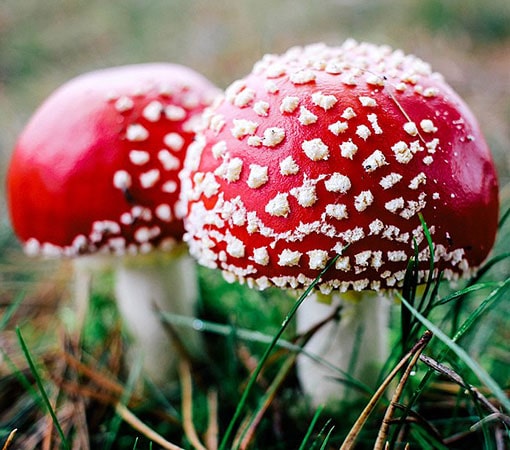
This mushroom species has inspired the look of the mushrooms in the legendary Mario game series and is how mushrooms are often depicted in cartoons or in children’s books (red mushrooms with big caps and white dots).
It was spread unintentionally almost everywhere in the world, and we find it especially in deciduous or coniferous forests.
The characteristics of these mushrooms include a large glossy bright red-blooded cap supported by a long white cylindrical leg.
When the mushroom emerges from the ground, the cap initially looks like a white egg. It gradually becomes hemispherical and gets a yellow or orange color, which finally turns red. When maturing, it then widens, reaching up to 8 inches (20 cm) in diameter, and its surface gets covered with irregular circular white dots that look similar to warts. Sometimes heavy rains detach these bumps, making Amanita muscaria easily confused with Amanita caesarea, an edible species.
Under the cap, it has white and thick gills, which can often have shades of yellow. The spores are white and oval in shape.
Amanita muscaria is toxic and contains neurotoxins with a strong hallucinogenic effect. Signs of poisoning with this mushroom occur relatively quickly after ingestion and are often characterized by disorders manifested by dizziness, delirium, convulsions, fainting, abdominal pain, vomiting, diarrhea, and excessive sweating.
For more info about Amanita muscaria, read this article.
2. Emetic Russula (Russula Emetica)
| Scientific Name | Russula emetica |
| Common Name | Emetic russula, The sickener, Vomiting russula |
| Family | Russulaceae |
| Toxicity | Toxic |
Russula emetica is one of about 100 red-capped Russula species known worldwide. It is prevalent in coniferous and hardwood forests throughout Europe but is also found in some regions of North Africa and Asia.
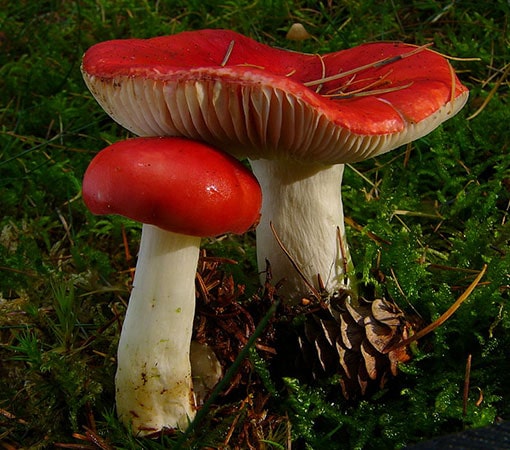
It prefers areas with high humidity and grows on the ground, near trees, forming a mycorrhizal connection with their roots. The tree provides sugars to the fungus, and the fungus, in exchange, supplies the plant with water and mineral nutrients from the soil.
Russula emetica is generally considered moderately toxic. Two of its most popular names refer to the unpleasant effects they can produce if consumed, such as “the sickener” or “vomiting russula.” In general, the effects of toxins occur fairly quickly after consumption and include symptoms such as nausea, vomiting, diarrhea, and severe abdominal cramps.
These mushrooms are distinguishable at maturity mainly through their cherry-red caps. When young, these have a convex shape which later flattens and sometimes forms a depression in the center. At maturity, the caps can get up to 3.3 inches (8.5 cm) wide.
On the underside of the cap, it contains intervenose (and occasionally forked) gills. They are white most of the time but usually turn yellow when the mushroom matures. The gills are at first quite close together and later they move away creating larger spaces.
The cap is supported by a sturdy white cylindrical foot with the base sometimes thickened, sometimes thinned, which usually reaches up to 3.1 inches (8 cm) in length.
3. Ox Tongue (Fistulina Hepatica)
| Scientific Name | Fistulina Hepatica |
| Common Name | Ox Tongue, Beefsteak, Tongue mushroom |
| Family | Fistulinaceae |
| Toxicity | Non-Toxic |
Fistulina Hepatica is a species of mushrooms that stands out not only through its red color but also by its strange shape. It is often found in forested areas of Europe but is also present in North America, Africa, and Australia.
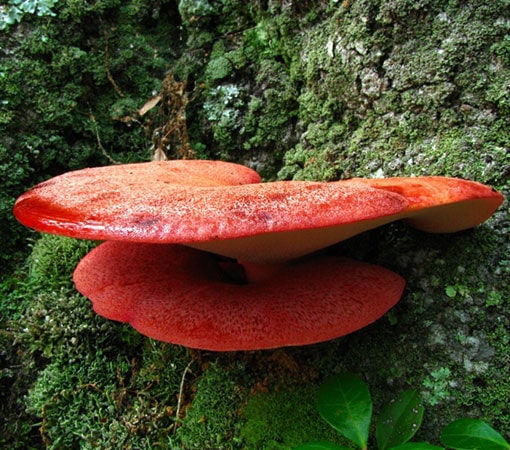
This mushroom has the shape and aspect of a large tongue, hence the popular names of the mushroom tongue, ox tongue, or beefsteak. It also has a similar texture to meat and even contains a red juice resembling blood.
Fistulina hepatica is a saprophytic and parasitic fungus. It usually grows in small groups or alone on rotten stumps or on the trunks of trees still in vegetation, preferring species such as chestnut or oak.
This species of mushroom is edible and is sometimes used as a meat substitute in various recipes. It has a slightly acidic and sour taste and is good to eat only when young. Once aged, the body of the fungus changes color from red to dark brown, its texture becomes soft and gelatinous and its juice can cause gastrointestinal problems.
It has a flash, succulent flattened body with lobed edges and can get up to nearly 12 inches (30 cm) in diameter. Its surface is reddish, rough, and doesn’t have any gills. As it is a parasitic species, it doesn’t have a leg and it is attached to a host.
4. Jackson’s Slender Amanita (Amanita Jacksonii)
| Scientific Name | Amanita Jacksonii |
| Common Name | Jackson’s Slender Amanita, American Slender Caesar, Eastern Caesar’s Amanita |
| Family | Amanitaceae |
| Toxicity | Non-Toxic |
Amanita jacksonii is a reddish-orange colored species of mushroom that can usually be found in the woodland regions from eastern Canada through the United States and Mexico.
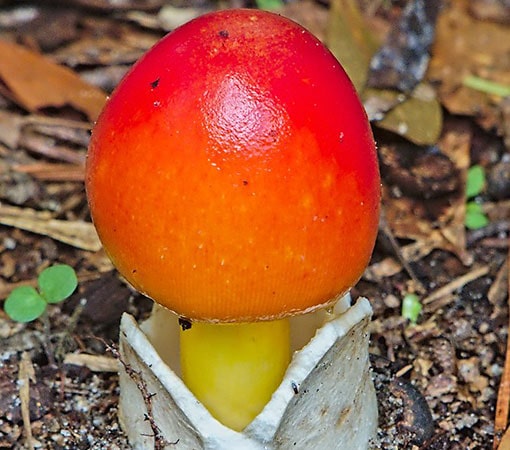
Some popular names for this species of mushroom include Jackson’s Slender Amanita, American Slender Caesar, and Eastern Caesar’s Amanita.
Soon after emerging from the soil, Amanita jacksonii has a red oval cap. Once the mushroom ages, the cap turns flat, typically with a bump in the center, and its red color gradually fades to the edges, gaining a color gradient ranging from red in the center to orange and yellow to the sides. When matures, the cap can grow up to 5 inches (12cm) in diameter.
It has moderately crowded to crowded yellow-to-orange gills free from the stem or slightly attached to it.
Many sources label Amanita jacksonii as an edible mushroom. Still, some firmly sustain that no mushrooms from the genus Amanita should ever be eaten as it is extremely easy to confuse an edible species with a toxic one. Amanita jacksonii is often misidentified with Amanita muscaria and Amanita phalloides, two highly toxic species from the same family. It also looks very similar to its cousin, Amanita caesarea, an edible species native to southern Europe and North Africa.
5. Stinkhorn Mushrooms (Phallaceae)
| Scientific Name | Phallaceae |
| Common Name | Stinkhorn mushrooms |
| Family | Phallaceae |
| Toxicity | Non-Toxic |
If you have found a reddish fungus with a strange shape that looks out of this world, emits a strong unpleasant odor, and attracts many insects, chances are you have encountered a fungus from the family Phallaceae. They have a worldwide distribution and are popularly called stinkhorn mushrooms.
Stinkhorns are odd mushrooms that stand out through their strange look and unpleasant odor. Their smell is so unpleasant that many even compare it to that of a decaying corpse or that of feces.
The stinkhorn fungi produce bodies above the ground only when ready to reproduce. For most of their lifespan, they are found only as fungal cells that feed with decaying organic matter.
Although according to a 2008 estimate, the family Phallaceae contains about 77 different species of fungi, not all are red-colored and there is a great variety in their shapes and colors.
Below are several species of stinkhorn fungi that form above-ground reddish bodies.
Starfish fungus (Aseroe rubra)

Basket stinkhorn (Clathrus ruber)
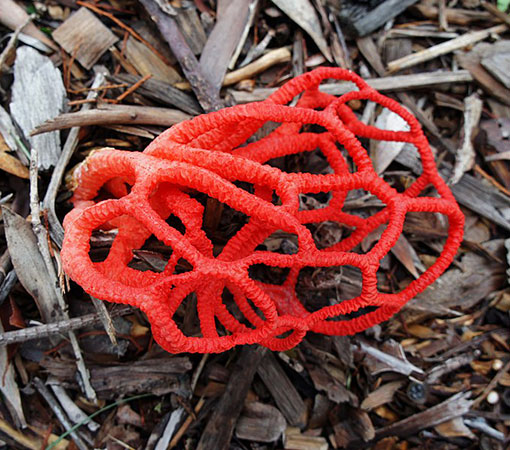
Octopus stinkhorn (Clathrus archeri)

Stinky squid (Pseudocolus fusiformis)

The dog stinkhorn (Mutinus elegans)
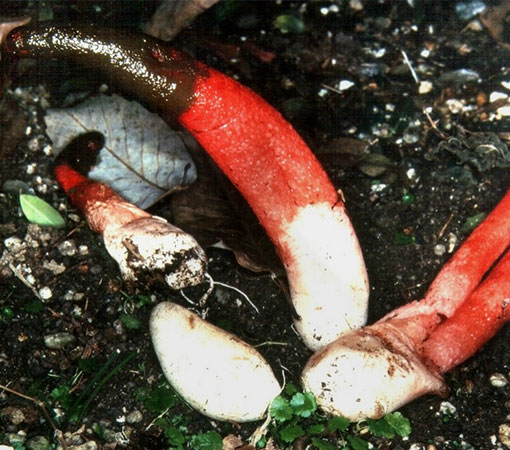
There are probably more, but these are some of the most common.
When they emerge at the surface of the soil, most fungi in this family first look like white spherical eggs. Soon after, they open, forming the body of the fungus.
When mature, stinkhorns produce a foul odor and have a repulsive aspect to humans. However, they are like a food call for flies and many species of bugs. Insects also represent the main way throughout which the spores of these fungi spread.
Although their shape, color, and odor look as if they tell us they are poisonous and we should not approach them, most species of stinkhorn mushrooms are generally considered non-toxic.
They are not edible at maturity, but in their egg stage, they do not release unpleasant odors and there are people who consume them.
If you want to know more about stinkhorn mushrooms, we invite you to read this article.
6. Cinnabar Red Chanterelle (Cantharellus Cinnabarinus)
| Scientific Name | Cantharellus cinnabarinus |
| Common Name | Cinnabar Red Chanterelle, Fire Chanterelle, Red Chanterelle |
| Family | Cantharellaceae |
| Toxicity | Non-Toxic |
You may be familiar with golden chanterelle (Cantharellus cibarius), but there is also a related species similar in look but reddish in color.
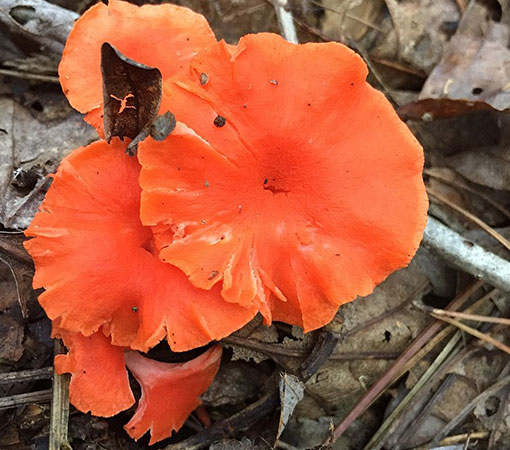
Cantharellus cinnabarinus, or Cinnabar Red Chanterelle as it’s commonly known is a species of mushroom native to eastern regions in North America. They usually grow on the ground of broadleaf forests or mixed broadleaf-conifer forests during late summer and fall.
This species of mushroom is considered edible and is even very appealing for its mild peppery taste. It is also a great source of iron, copper, fibers, and vitamin D.
Cantharellus cinnabarinus are usually easily identifiable due to their shape and flamingo-pink to reddish-orange color. Still, sometimes they are confused with lookalikes such as Hygrophoropsis aurantiaca (the false chanterelle) or Omphalotus illudens (Jack-o’-Lantern). While the false chanterelles are considered non-toxic, Jack-o’-Lanterns are poisonous.
Cantharellus cinnabarinus is a tiny mushroom. Its cap rarely exceeds 2 inches (5 cm) in diameter, has a smooth surface with a trumpet or funnel shape, and curled edges. Underneath the cap, it has forked false gills (with a slightly lighter shade than the top) which go down the stem. The stem is thin and has roughly the same color as the cap but becomes lighter at the base.
Although we can find these mushrooms growing in small pairs of two to six exemplars, they don’t grow in large clusters as their poisonous look-a-likes, Jack-o’-Lanterns, do. They also only grow on the ground, around trees, not in open fields, and not on living or dead wood.
7. Frost’s Bolete (Butyriboletus frostii)
| Scientific Name | Butyriboletus frostii (formerly Boletus frostii or Exsudoporus frostii) |
| Common Name | Frost’s bolete, Apple bolete, Candy-apple bolete |
| Family | Boletaceae |
| Toxicity | Non-Toxic |
Butyriboletus frostii, popularly known as Frost’s bolete or the apple bolete, is a species of mushrooms found in regions in Northern and Central America, Mexico, and Costa Rica. It is a mycorrhizal fungus that creates a mutually beneficial symbiotic connection with the roots of some hardwood tree species, particularly with oaks.

Frost’s bolete can grow in small groups or solitarily and can be found on the ground of hardwood forests from late summer to early autumn. It is identified primarily through its shiny dark-red cap color supported by a leg with a network-like pattern.
Initially, the cap has a bright red color, with a hemispheric-to-convex shape that becomes broadly convex to flat when the mushroom ages. In wet conditions, its surface becomes sticky, getting the aspect of a red candy apple, hence its popular name.
These mushrooms don’t have any gills on the underside of the cap. Instead, they possess tubes and pores. The caps’ edges, are frequently slightly curled inward but can uncurl or even swing upward when aging. Occasionally, they have a light yellow color.
When wounded, the affected areas of these mushrooms get a dark blue color. This is not a particularity of Butyriboletus frostii, but a characteristic shared between several species of fungi in the Boletaceae family. Consequently, it is not a feature you can rely entirely on to identify this species.
Butyriboletus frostii mushrooms are generally considered non-toxic. However, they have not been subject to enough studies to prove that they are completely safe for consumption. Additionally, they can easily be mistaken with other poisonous red-pored boletes, such as Boletus rubroflammeus, hence, many advise against eating these mushrooms.
8. Poison Fire Coral (Podostroma cornu-damae)
| Scientific Name | Podostroma cornu-damae |
| Common Name | Poison Fire Coral |
| Family | Hypocreaceae |
| Toxicity | Extremely Toxic |
Podostroma cornu-damae or Poison fire coral as it’s commonly called, is a species of fungus native to Japan, China, and Korea. It was more recently also discovered in Papua New Guinea, Indonesian Java island, and in some regions of Australia.
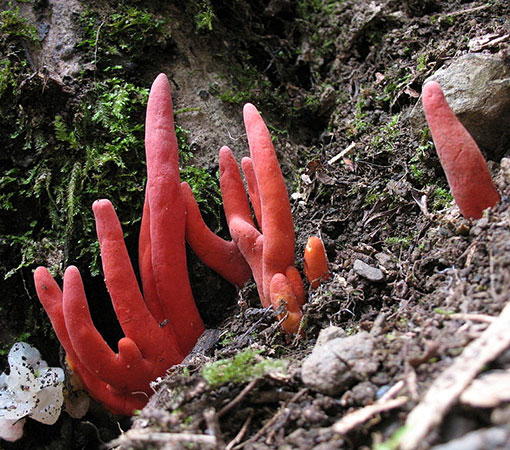
The fruit body of this fungus doesn’t look like the typical mushrooms but resembles more with a cluster of red horns coming out of the ground.
Podostroma cornu-damae are some of the most poisonous mushrooms in the world. Their fruit body contains a highly potent toxin called “trichothecene mycotoxins,” which even in small doses can be fatal to an adult person.
Although this fungus is pretty rare, several deaths through poisoning by Podostroma cornu-damae have been reported in Japan and other countries over time.
According to the same source, the early symptoms of poisoning with these mushrooms include abdominal pain, vomiting, diarrhea, and fever. These are usually followed by hypotension, changes in perception, confusion, difficulties at motion and at speech, etc.
Without medical help, more severe signs occur such as skin peeling, hair loss, thrombocytopenia, and leukopenia, usually followed by death due to multiple organ failure.
Until recently, this fungus was thought to be located only in Asia. However, in recent years it has been also observed in parts of Australia, creating fear among mycologists.
Dr. Matthew Barrett, an Australian University mycologist, strongly advises people not only not to eat this mushroom, but also not to touch it by any means. According to him, Podostroma cornu-damae is the only known poisonous mushroom in which the toxins can also be transferred through the skin.
9. Scarlet Elf Cup (Sarcoscypha coccinea)
| Scientific Name | Sarcoscypha coccinea |
| Common Name | Scarlet elf cap, The scarlet cup |
| Family | Sarcoscyphaceae |
| Toxicity | Non-toxic |
Sarcoscypha coccinea is a saprophytic species of fungus spread almost on all continents. This mushroom is also popularly known as the scarlet elf cup or the scarlet cup.
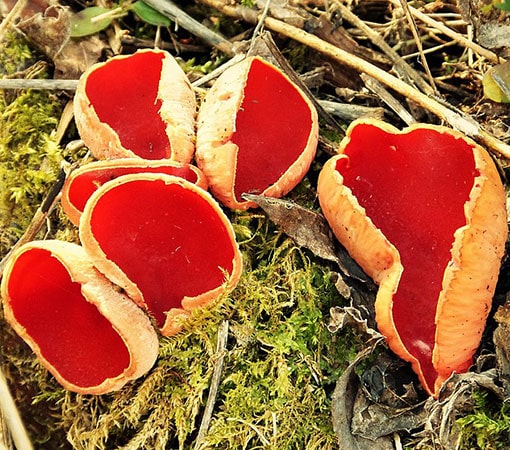
This fungus is found mainly in deciduous forests and is often spotted around hazelnut, various maples, alder, willow, and aspen. It feeds on dead organic matter like decaying fallen tree trunks and dry branches. It prefers humid environments and usually appears in early spring.
Although there are several species of fungi that can be mistaken with, Sarcoscypha coccinea is usually quite easy to recognize.
In the early stage, the fruiting body of the scarlet elf cup it’s white, closed, and has a globular shape similar to an eye. Later, it opens, and the cap becomes bright red on the inside and light pink on the outside.
When aging, the cap gets the shape of a cup, turns crimson red on the inside, and reddish-orange on the outside. Its surface is smooth and has wavy edges turned inwards. Over time, it gains an irregular shape, usually, with cracks on the edges. The cap’s red color may also fade in time and will sometimes even turn almost orange.
The foot, when present, is short, thin at the base, and with the surface covered by a fine fluff, usually white but with a reddish tip.
It is not a mushroom that reaches very large sizes. Usually, its cap does not exceed a diameter of 2.5 inches (roughly 6 cm). However, it customarily grows in large groups.
Although generally considered non-toxic, the edibility of Sarcoscypha coccinea is not precisely established. Still, the young exemplars of this species are consumed in some regions of the world (only thoroughly cooked).
10. Scarlet Waxcap (Hygrocybe Coccinea)
| Scientific Name | Hygrocybe coccinea |
| Common Name | Scarlet waxcap, Scarlet waxy cap, Scarlet hood, Righteous red waxy cap |
| Family | Hygrophoraceae |
| Toxicity | Non-toxic |
Hygrocybe coccinea is a medium-sized species of red mushrooms distributed in various regions of the world, such as parts of Asia, Europe, and North America. It is usually found in mixed forests and grasslands and normally occurs in late summer, autumn, or even early winter.
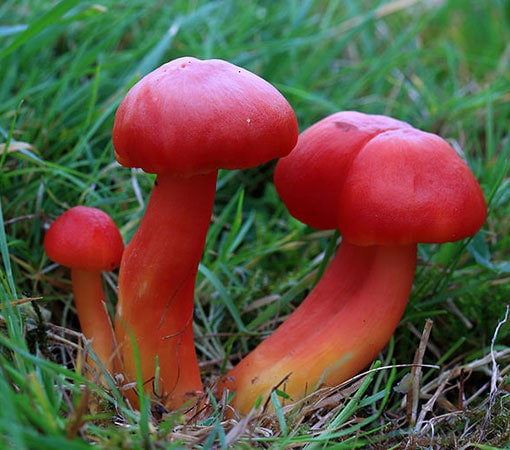
Like most mushrooms in the genus Hygrocybe, the scarlet waxcap is easy to identify due to its waxy hat and other common characteristics of the waxy cap mushrooms. Other Hygrocybe species are likewise the mushrooms with which Hygrocybe Coccinea is most often confused.
Although it has many similar characteristics to the mushrooms in the same group, Hygrocybe Coccinea stands out, primarily through the scarlet red color of its hat.
It has the classic shape of a mushroom, grows on the ground, and has a leg that supports the hat which doesn’t reach impressive sizes. It generally does not exceed 2.5 inches (6 cm) in diameter.
At first, the hat of this mushroom has the shape of a bell, then it becomes hemispherical, and at maturity convex, flattening towards the end of its life cycle. The edges are wavy and sometimes develop cracks. Under the hat, it has well-spaced and robust gills connected to the stem, with a blood-red color or a shade of orange.
The leg usually has a color similar to that of the cap but is lighter at the base.
Hygrocybe Coccinea is generally considered non-toxic and edible. However, it can very easily be mistaken with Hygrocybe punicea (Crimson scarlet waxy cap), which is also regarded as edible in some regions, but also as inedible in others due to some reports of gastrointestinal problems after ingestion.
Final Word
This is just a small selection of red mushroom species that you can find throughout the world. They are often easy to spot in the green grass or on the trunks of trees due to their color that stands out.
We hope you found this list helpful and will help you more quickly identify mushrooms with this feature.
Since you have reached the end of the article, you may also be interested in our selection of 10 yellow mushroom species.
Please do not eat any species of mushrooms based only on the information presented in this article! Always consult a specialist before determining whether a mushroom is safe for consumption or not.

